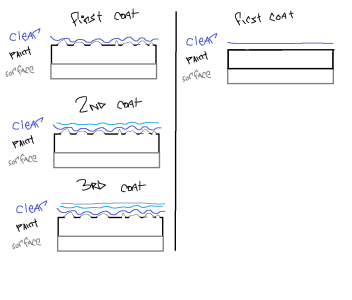A clearcoat works like a waterlike mirror on top of your project, so if u poor that goodie over a un even surface it will look like there are waves in the mirror.
The more coats u throw (wet coat over wet coat) , the more the clearcoat will fill itself and all the uneven places and the waves become more even and mirror flat.
So if your painting already looks uneven the clearcoat will show that , but can be fixed with alot of clearcoat until it's even.
I did this little drawing , on the left is when paint sticks out and is not even.
on thje right the paint is even.
View attachment 51827
Another example picture(the right shows that also clearcoat does sometimes give gridpaper effect) , thats why clearcoats also needs sanding after drying)
So the more uneven the basecoat / paint or primer , the more clearcoat u need to fill and even it.
The best way is good prepping , make the surface smooth to start with , prime the surface and sand that smooth again.
Then your basecoat is already much smoother , and the paint on top also.
But if your basecoat is silky smooth and the airbrush paint will make your project bumped up then u can:
1. Reduce your paints more.
2. Too much overspray will give orangepeel (grid like) ,
problem overspray: paints sprayed in too thick layers , too much pressure
3. Test your paints with more or less heat as temperature can effect your paint curing (paints need to settle down)
I hope this helps
ps. sorry for the bad english (iam a dutchie).
greets Souldog Airbrush




